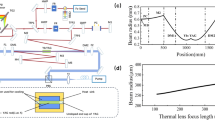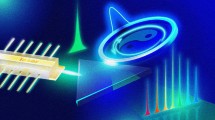Abstract
Numerical analysis of Transistor Laser is carried out to investigate the influence of Franz-Keldysh (F-K) Effect on the non-linear distortion characteristics such as intermodulation (IM). The device considered for the study incorporates an intrinsic GaAs absorption layer in the collector–base junction of a TL emitting around 980 nm. The base current threshold is obtained as 39 mA for the collector to base voltage of 1 V and it is discerned that the threshold current of TL is dependent on electric field in addition to the bias current. The analytical solution of rate equations at steady state is derived and compared with the numerical simulation and the same is plotted for VCB = 1 V. Moreover, maximum optical light output loss of 12 mW and 1.37 mA additional current is contributed to the collector current for collector base voltage of 3 V, under various base currents due to F-K effect. The modulation bandwidth (f-3 dB) of TL under voltage modulation is obtained as 9.63 GHz. While, under current modulation, it is found as 8.38 GHz respectively. A maximum modulation depth of 86% is obtained for IB = 1.06Ith, at 2.4 GHz. The frequency components related to intermodulation product, IMD3 (2.15 GHz) magnitudes are obtained as − 10.26 dBc, − 12.37 dBc, − 13.54 dBc and − 15.92 dBc for VCB voltage value of 0 V, 1 V, 2 V and 3 V respectively. The intermodulation product, IMD5 (2.05 GHz) magnitudes are obtained as − 18.89 dBc, − 25.76 dBc, − 28.22 dBc and − 36.05 dBc for the collector bias voltage (VCB) value of 0 V, 1 V, 2 V and 3 V respectively. In both cases, the intermodulation is found to decrease with increase in F-K absorption.











Similar content being viewed by others
References
G. Walter, N. Holonyak Jr., M. Feng, R. Chan, Laser operation of a heterojunction bipolar light-emitting transistor. Appl. Phys. Lett. 85, 4768 (2004)
N. Holonyak Jr., M. Feng, The transistor laser. IEEE Spectr.Spectr. 43, 50–55 (2006)
H.W. Then, M. Feng, N. Holonyak Jr., The transistor laser: theory and experiment. Proc. IEEE 101, 2271–2298 (2013)
L.X. Zhang, J.-P. Leburton, Modeling of the transient characteristics of heterojunction bipolar transistor lasers. IEEE J. Quant. Electr. 45, 359–366 (2009)
B. Faraji, W. Shi, D.L. Pulfrey, L. Chrostowski, Analytical modeling of the transistor laser. IEEE J. Sel. Top. Quantum Electron. 15(3), 594–603 (2009)
M. Shirao, S.H. Lee, N. Nishiyama, S. Arai, Large signal analysis of a transistor laser. IEEE J. Quant. Electr. 47(3), 359–367 (2011)
R. Bambery, F. Tan, M. Feng, J.M. Dallesasse, N. Holonyak Jr., Voltage andcurrent modulation 20 Gb/s of a transistor laser at room temperature. IEEE Photonics Technol. Lett. 25(9), 859–862 (2013)
M. Feng, J. Qiu, C.Y. Wang, N. Holonyak Jr., Intra-cavity photon-assisted tunneling collector-basevoltage-mediated electron-hole spontaneous-stimulated recombination transistor laser. J. Appl. Phys. 119(8), 084502 (2016)
C.H. Chang, S.W. Chang, C.H. Wu, Theory for voltage modulation of transistor lasers using Franz-Keldysh absorption in the presence of optoelectronic feedback. OSA Publishing, Optic Express 24(22), 25515 (2016)
H.-L. Wang, Y.-H. Huang, G.-S. Cheng, S.W. Chang, C.-H. Wu, Analysis of tunable internal loss causedby Franz-Keldysh absorption in transistor lasers. IEEE J. Sel. Top. Quantum Electron. 21(6), 270–276 (2015)
A. James, N. Holonyak, M. Feng, G. Walter, Franz-Keldysh photon-assisted voltage-operated switching ofa transistor laser. IEEE Photonics Technol. Lett. 19(9), 680–682 (2007)
R. Ramya, S. Piramasubramanian, Effect of Franz-Keldysh absorption on the short optical pulse generation in Transistor Laser. Optics Communications 474, 126087 (2020)
R. Ramya, S. Piramasubramanian, M.G. Madhan, D. Rebecca, Effect of collector voltage on the large and small signal modulation characteristics of 980 nm transistor laser. Def. Sci. J. 70(5), 529–533 (2020)
A. Winoto, J. Qiu, D. Wu, M. Feng, Optical NOR Gate Transistor laser integrated circuit, Conference on lasers and electro-optics (CLEO), OSA technical digest, Optica Publishing Group, (2019).
L. Fan, P. Jia, Y. Lei, Q. Cui, Y. Chen, Li. Qin, L. Liang, C. Qiu, Y. Song, Y. Wang, Y. Ning, L. Wang, Modulation characteristics of high-speed transistor lasers. Appl. Sci. 12(9), 4475 (2022)
S. Piramasubramanian, M.G. Madhan, J. Nagella, G. Dhanapriya, Numerical analysis of distortion characteristics of heterojunction bipolar transistor laser. Opt. Commun.Commun. 357, 177–184 (2015)
S. Piramasubramanian, M.G. Madhan, V. Radha, S.M.S. Shajithaparveen, G. Nivetha, Effect of quantum well position on the distortion characteristics of transistor laser. Optics Communications 414, 22–28 (2018)
S.V. Vinodhini, S. Piramasubramanian, M.G. Madhan, Analysis of nonlinear distortion and its reduction using feedback injection schemes in an 1.3μm transistor laser. Optics Communications 439, 224–232 (2019)
L.A. Coldren, S.W. Corzine, M.L. Mashanovitch, Diode lasers and photonic integrated circuits (John Wiley and Sons, 2012)
K. Tharmalingam, Optical absorption in the presence of a uniform field. Phys. Rev. 130(6), 2204–2206 (1963)
C.-T. Tung, S.-W. Chang, C.-H. Wu, High speed data transmission under voltage modulation of transistor lasers, Proceeding of the 23rd opto electronics and communications conference technical digest July 02–06, Jeju, Korea, (2018)
Author information
Authors and Affiliations
Contributions
R. Ramya executed the idea, performed results and analyzed the results and paper writing work. S. Pirasubramanian reviewed the work, validated the results. M. Ganesh Madhan has given the idea, continuously provided the guidance and given many valuable inputs.
Corresponding authors
Ethics declarations
Competing interests
The authors declare no competing interests.
Additional information
Publisher's Note
Springer Nature remains neutral with regard to jurisdictional claims in published maps and institutional affiliations.
Rights and permissions
Springer Nature or its licensor (e.g. a society or other partner) holds exclusive rights to this article under a publishing agreement with the author(s) or other rightsholder(s); author self-archiving of the accepted manuscript version of this article is solely governed by the terms of such publishing agreement and applicable law.
About this article
Cite this article
Ramya, R., Piramasubramanian, S. & Madhan, M.G. Influence of Franz Keldysh effect on the modulation depth and distortion characteristics of transistor laser. Appl. Phys. B 130, 95 (2024). https://doi.org/10.1007/s00340-024-08224-x
Received:
Accepted:
Published:
DOI: https://doi.org/10.1007/s00340-024-08224-x




